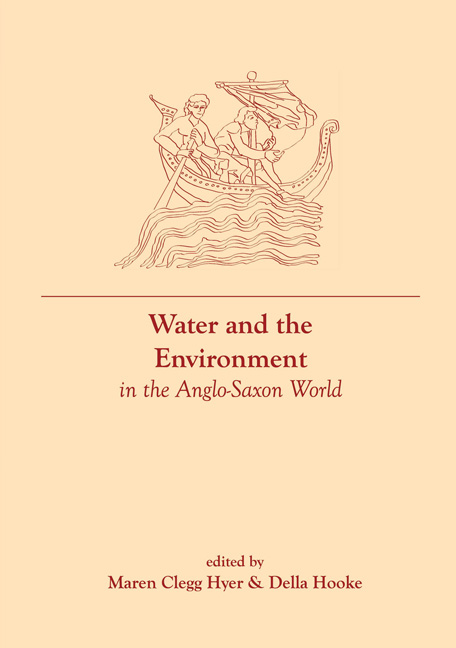Book contents
- Frontmatter
- Dedication
- Contents
- List of Illustrations
- List of Tables
- List of Contributors
- Introduction
- 1 From Whale's Road to Water under the Earth: Water in Anglo-Saxon Poetry
- 2 Water in the Landscape: Charters, Laws and Place Names
- 3 Fens and Frontiers
- 4 Marshlands and Other Wetlands
- 5 Rivers, Wells and Springs in Anglo-Saxon England: Water in Sacred and Mystical Contexts
- 6 Food from the Water: Fishing
- 7 Inland Waterways and Coastal Transport: Landing Places, Canals and Bridges
- 8 Watermills and Waterwheels
- 9 Water, Wics and Burhs
- Notes
- Suggested Reading
- Index
2 - Water in the Landscape: Charters, Laws and Place Names
- Frontmatter
- Dedication
- Contents
- List of Illustrations
- List of Tables
- List of Contributors
- Introduction
- 1 From Whale's Road to Water under the Earth: Water in Anglo-Saxon Poetry
- 2 Water in the Landscape: Charters, Laws and Place Names
- 3 Fens and Frontiers
- 4 Marshlands and Other Wetlands
- 5 Rivers, Wells and Springs in Anglo-Saxon England: Water in Sacred and Mystical Contexts
- 6 Food from the Water: Fishing
- 7 Inland Waterways and Coastal Transport: Landing Places, Canals and Bridges
- 8 Watermills and Waterwheels
- 9 Water, Wics and Burhs
- Notes
- Suggested Reading
- Index
Summary
Ærest of pennpoll lannmoren up bi þam broce oð hræt winiau þonne forð 7 lang broces to pen hal þonne to maen wynn þonne to oðrum pen hal þonne adun by þam broce to sæ
First from penpoll lannmoren [Cornish for ‘Lamorran creek's head’] up by the brook as far as hræt winiau [‘(the)? ford’]; then onwards along (the) brook to (the) head of the marsh; then to mæn wynn [‘(the) white stone’]; then to the other pen hal [‘(the) head of the marsh’]; then down by the brook to (the) sea. (Boundary clause of Lamorran, Cornwall, AD 969)
Introduction
This chapter looks at how contemporary documents reveal how administrative arrangements valued water and how watercourses were often followed by boundaries. These documents, too, often offer the earliest written evidence for the names by which rivers and lesser watercourses were known in this period and offer material not readily available elsewhere. Some settlements taking their names from rivers might first appear in Domesday Book, which, although it was compiled soon after the Norman Conquest, nevertheless presents a picture of late Anglo-Saxon England. From these early sources, important information can be gleaned about ways that the waters all around them touched the daily life of people in this period in myriad ways.
Rights to rivers and other watercourses in documentary sources
Rights to water frequently find mention in pre-Conquest charter grants or leases, usually as the appurtenances of estates in the Latin preamble. Sometimes they are expressed as rights in aquarum cursibus ‘running waters’ or diriuatisque aquarum cursibus/dirivatisque cursibus aquarum/ aquis, aquarumque decursibus, variants of ‘running streams of water’, or merely as in aquae ‘in waters’, in flumine, rivulis or aquarum riuulis ‘in rivers’ or ‘in the water of rivers’. Kentish charters, especially, may note rights in other waters and wetlands: fontanis, paludibus, fluminibus ‘(in) springs, marshes and rivers’: marshes and rivers were places for the capture of fish and fowl.
- Type
- Chapter
- Information
- Water and the Environment in the Anglo-Saxon World , pp. 33 - 67Publisher: Liverpool University PressPrint publication year: 2017



